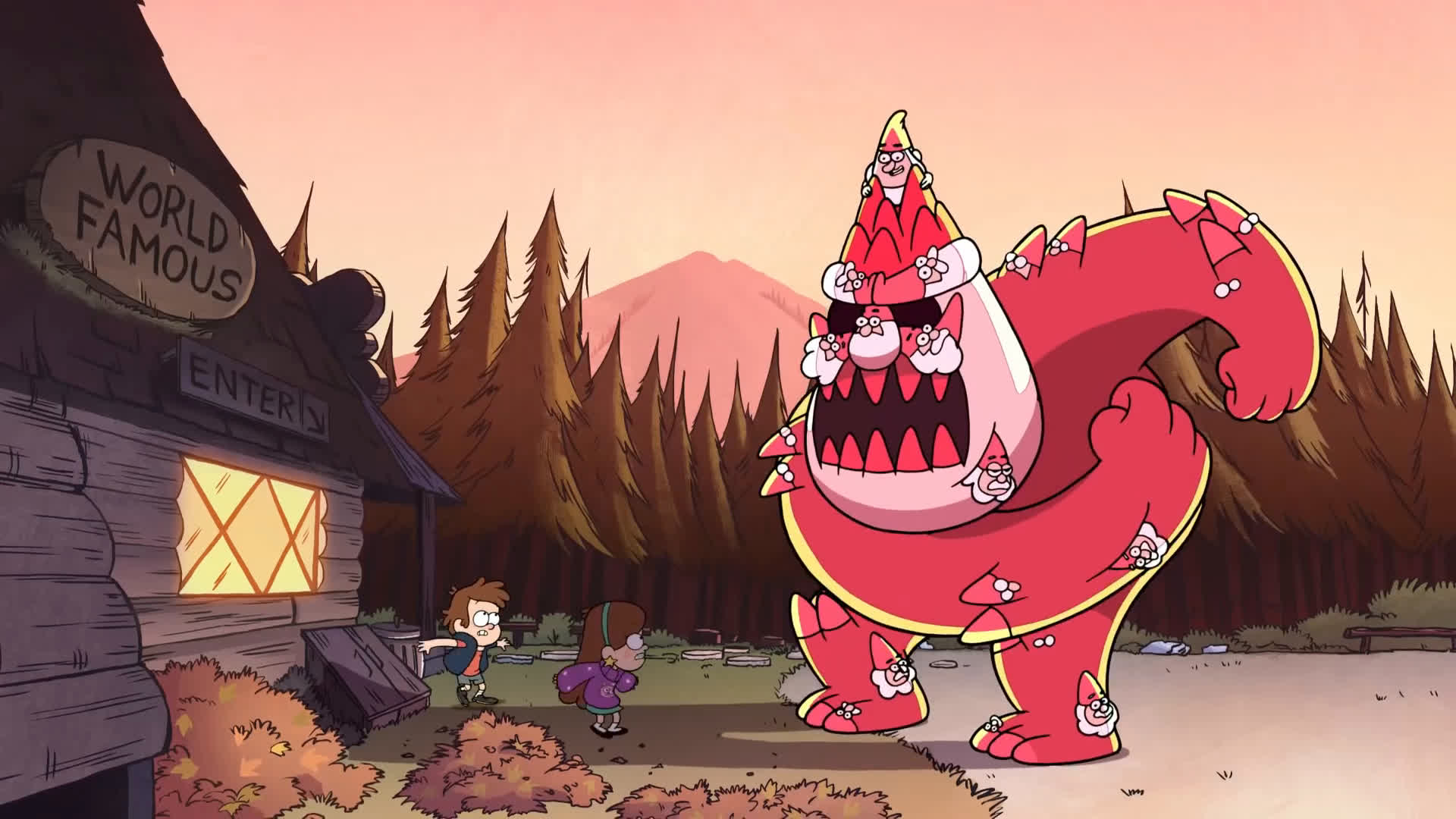Table of Contents Show
Spoilers for Gravity Falls (2012-2016) included going forth.
When thinking of examples of interactive television, fans tend to list Netflix’s Bandersnatch (a choose-your-own-adventure episode) or voting for your favorite singer on The Voice. However, interactive media can also invite the audience to participate by collecting, dissecting, and sharing information in order to help tell the story. When Gravity Falls (2012) aired on the Disney Channel, it invited its audience to participate by leaving hidden clues in order to predict some of the show’s biggest mysteries. Gravity Falls, created by Alex Hirsch, followed twins Dipper and Mabel as they spent their summer with their Great Uncle Stan in his home-turned-tourist-trap called the Mystery Shack.
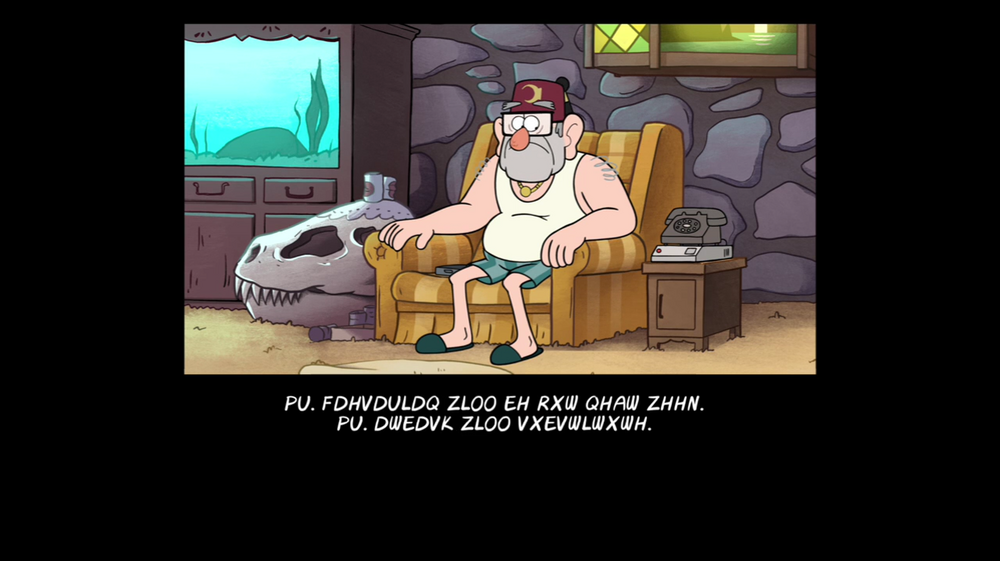
Together, the twins attempted to solve the supernatural mysteries of the town and find the author of a mysterious book called Journal 3. Along the way, a demon named Bill Cipher thwarted Dipper and Mabel’s plans, seeking to use the Pines family to lead the world towards ultimate destruction. The series ended with Bill Cipher taking over the town of Gravity Falls but ultimately being defeated and turned to stone. Throughout its two seasons, Gravity Falls had a series of paratexts (materials associated outside of the show) like books and games to help the audience put together the narrative of the town and the characters who reside within it. The show culminated with a scavenger hunt from Russia to Oregon, searching for Bill Cipher’s statue.
These extra texts helped to expand on the show’s story and served as a way for the characters to directly communicate with the audience and invite them into the world. Gravity Falls created a new standard for interactive media by inviting the audience to interact with the story as if they were a character in the show. Though it’s been nearly ten years since the show’s initial release, it continues to remain an iconic example for audience participation. Inviting audiences to participate within the story is more than just a publicity stunt or gimmick. Rather it is a sign of gratitude towards audiences for their dedication by giving them a place of importance within the narrative.
Cracking The Codes
One of the most common forms of audience interaction came in the form of hidden cryptograms in every episode of Gravity Falls. At the end of each episode, a hidden code (called a cipher) would appear at the end of the credits, inviting the audience to uncover a joke or hint about what was to come in future episodes. Five main types ((Fitzpatrick, Insha. Mysteries of Gravity Falls: Cryptograms and Ciphers. Women Write About Comics. January 28, 2016.)) of ciphers were used throughout the show’s run:
- Caesar cipher — substitute the original letter for the third letter that comes before it in the alphabet (A = X)
- Atbash cipher — the original letter is replaced by its opposite in the alphabet (A = Z)
- A1Z26 cipher — substitute the number with the letter it represents in alphabetical order (1 = A)
- Vigenère cipher — a series of Caesar ciphers solved using a keyword and the Vigenère square
- Substitution cipher — the original letters are replaced with non-alphabetic symbols
However, in order to know which cipher would crack the code, audiences needed to pick up on other clues first. An episode in season one had a secret code in the end credits that read, “Mr. Caesarian will be out next week. Mr. Atbash will substitute”. This signaled to the audience that the cipher was going to change in future episodes. The theme song also included some of the most important clues for the audience. Towards the end of the song, a faint whisper could be heard that when played forward said “I’m still here,” but when played backward, would say “go three letters back.” This was the audience’s clue to use a Caesar cipher. The whisper in the theme song would also change throughout the series to other ciphers, including “twenty-six letters” and “Key Vigenère.”
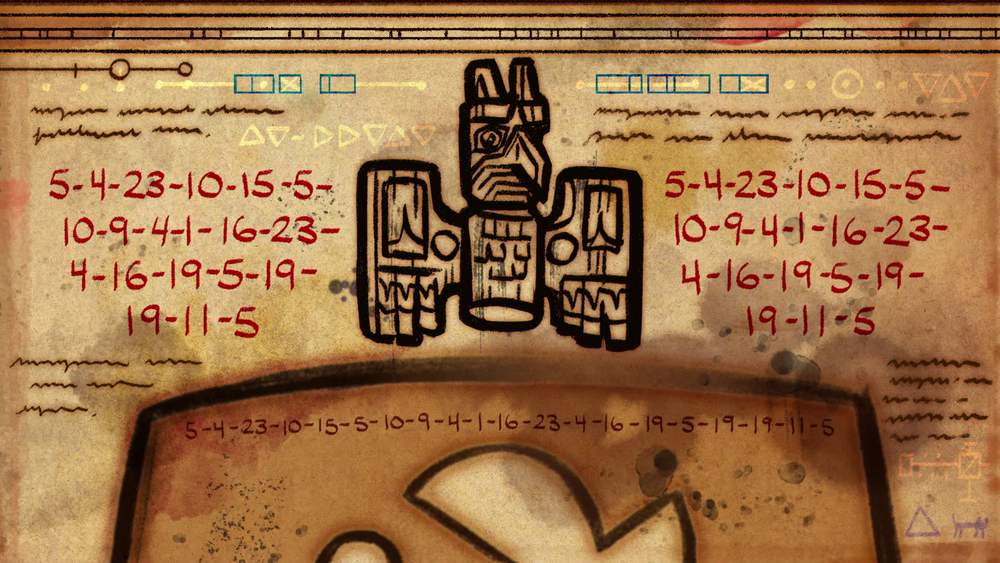
Season two would take the secret codes to a new level and introduce a series of puzzle pieces to the audience. Not only did each of these pieces have a Vigenère cipher that needed to be solved (using a keyword hidden within each episode), but the pieces would come together to form a larger image at the end of the series. The added puzzle offered layers of clues and codes that audiences needed to solve in order to gain extra information. The secret codes were the first step in integrating audiences into the world of Gravity Falls and allowing them to become active participants in the story.
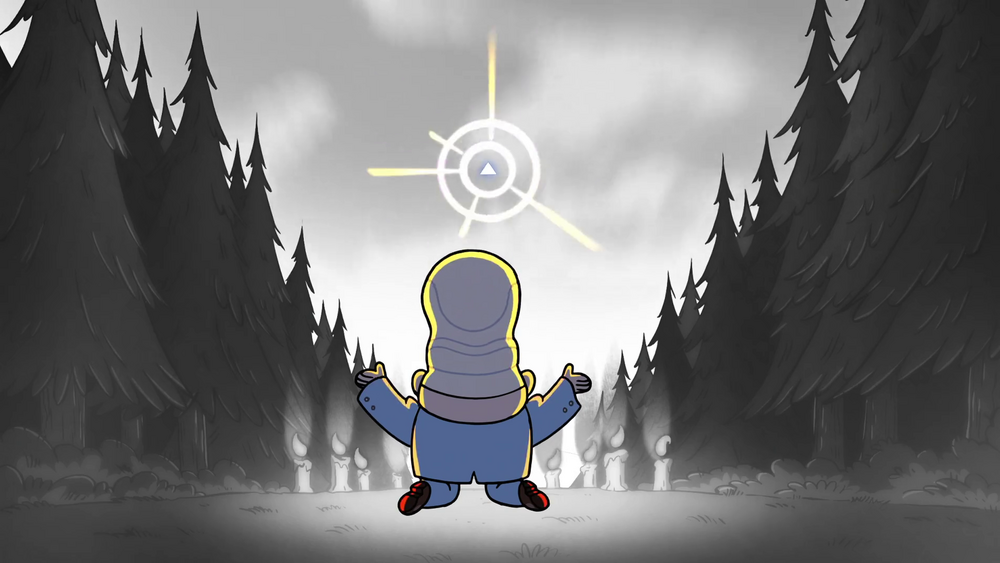
For many fans, the secret codes served as fuel for their fan theories about who the author of the Journal was or about Bill Cipher’s eventual take over of the town. Waiting for the secret code at the end of every episode was just as exciting as the episode itself. For many, the ciphers offered a gateway towards community involvement. After each episode, fans would get together on social media to decode and discuss the show’s secrets. The codes fostered a sense of community and togetherness within the fanbase.
Backward Messages
As the secret message hidden in the theme song previewed, backward messages played a significant role within the show as well. As an homage to its predecessor Twin Peaks ((Dickey, Josh. “Watch David Lynch coach Laura Palmer on ‘Twin Peaks’ backward-talk.” Mashable. December 4, 2017.)) and the famous Red Room, Gravity Falls employed the use of backward speech for magic spells. First seen in the episode “Dreamscapers,” Gideon is the first character known to speak backward when summoning Bill Cipher. When played forward, he says the phrase “backward message” six times. While this may seem like a detail hidden to make fun of or annoy die-hard fans, audiences loved the jokes hidden within the series. Solving the backward messages allowed the audience to become involved in the story and served as a form of reward or encouragement for fans’ to keep solving mysteries.
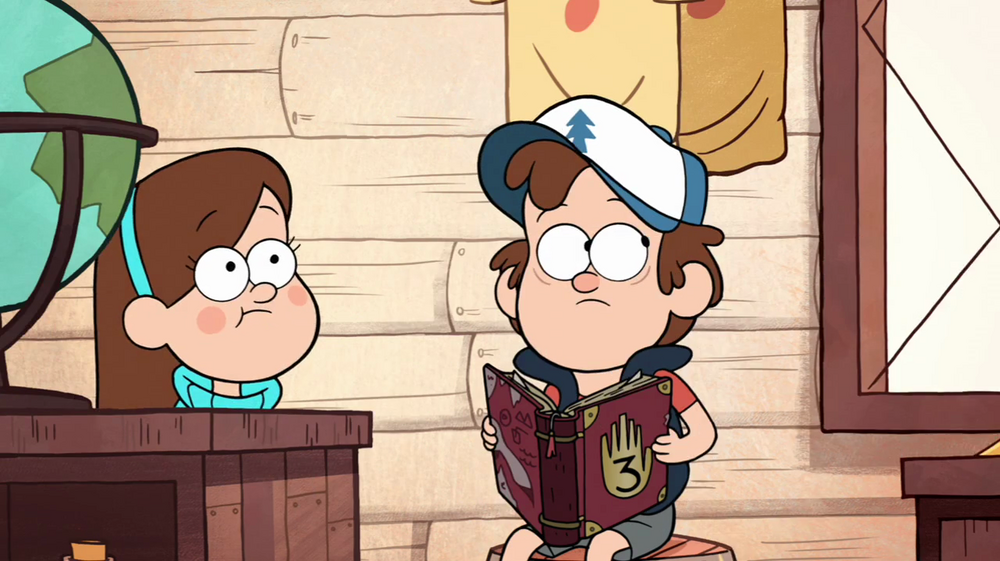
In the series finale, Bill Cipher’s final words are backward as he proclaims, “A-X-O-L-T-O-L. My time has come to burn. I invoke the ancient power that I may return!” This backward message hints to audiences that Gravity Falls may not be over yet, and Bill may be planning his (and the show’s) eventual return. It also marks the first mention of The Axolotl, a character who is only seen in the later book releases. This message remains one of the most significant within the series. Just as the secret codes encouraged fans to communicate with each other and form online communities, so did the backward messages. Bill’s final message sparked hope within the audience that the show would continue, and to this day, provides fans with plenty to speculate about.
Playing With Paratexts
Paratexts serve as outside sources of information in regards to a media franchise, like a film or TV show. They offer the audience a chance to explore the lives of characters off-screen or to gain further details about a world. Companion guides are the most recognizable form of paratexts, but they can also come in the form of video games, director’s commentaries, and other promoted materials. Though Gravity Falls told a compelling and satisfying story within its two seasons, creator Alex Hirsch made expert use of paratexts to flesh out the world of the show and encouraged audiences to engage outside of the screen.
The Video Games
Video Games are one of the most obvious ways audience members can interact with the world of the story. Games allow players to act as characters to defeat enemies, explore a world, or gather information. Disney often releases online games related to running TV shows, and Gravity Falls was no different. “Rumble’s Revenge” was released on January 11, 2013, during the show’s first hiatus and offered valuable clues to the audience. It left six hints in the form of codes about the remainder of season one and even a glimpse into season two. Some of the notable hints were: “There is a secret society in Gravity Falls,” “Dipper is playing with fire,” and “I will be returning to Gravity Falls.” When specific letters from each hint were combined, they spelled the phrase “My name is Bill.”
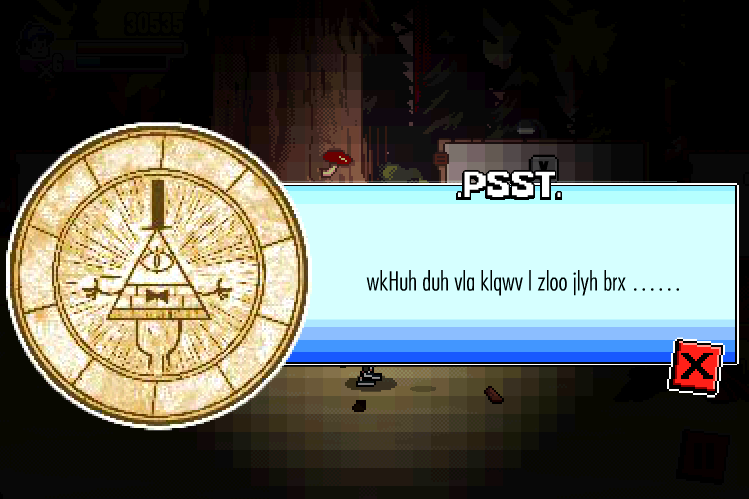
This served as Bill’s first formal introduction, six months before appearing in the episode “Dreamscapes.” For fans who played the game, not only was this the first time they were able to interact with the town of Gravity Falls virtually, it provided them with some of the most important information about the plot to date. Throughout the remainder of season one (and even season two), fans speculated in online forums and blogs about what each of the clues might mean. For fans, it was almost like a race against the clock to predict what would happen next.
Gravity Falls also released a Nintendo 3DS game titled Gravity Falls: Legend of the Gnome Gemulets. While this game also featured secret codes, it predominantly focused on fleshing out the characters. The game provided characters with opportunities to interact and have conversations that might seem out-of-place in an episode, such as Grunkle Stan mentioning he was present for the twins’ birth. Audiences enjoyed the opportunity to experience the town of Gravity Falls and interact in live time with some of the characters. Alex Hirsch has even stated that (with Disney’s permission) he would want to create an immersive, role-play style game to serve as a third season for the show (( Motamayor, Rafael. “Gravity Falls Season 3 Could Exist As a Video Game, Creator Says.” Inverse. March 29, 2021. )).
In this way, video games allow audiences a chance to view a TV show through the first-person perspective. The audience actively inhabits a character and moves them through the story with a sense of agency. Players are able to linger in the setting and observe details they may not have previously noticed about the story. For Gravity Falls, the opportunity to use online games as part of its lore and world-building was the perfect way to increase audience interaction.
The Books
Gravity Falls released a series of books about the show throughout its run, including a graphic novel, coloring book, and a choose-your-own-adventure story. Almost every companion book contained extra secret codes for the audience to solve but also expanded upon the plot. Dipper’s and Mabel’s Guide to Mystery and Non-Stop Fun left clues for the audience about the oncoming apocalypse that would serve as the show’s finale. It also offered interactive activities like a decoder chart and certificates to be signed by the reader as proof of their dedication.
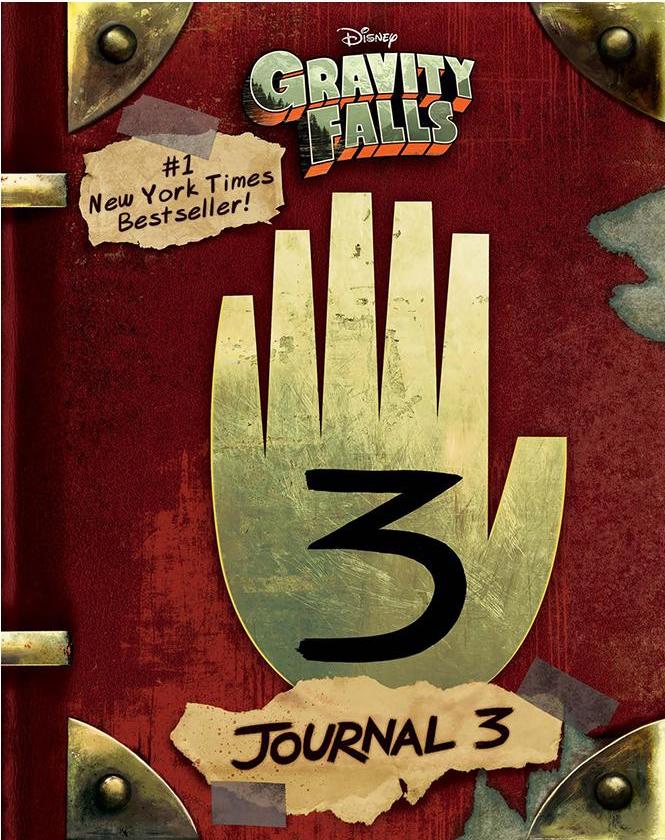
The print release of Journal 3 in the summer of 2016 offered fans an opportunity to interact with a prop from the show. Not only are tangible objects related to film and TV deeply important to fans, but these items allow the story to deepen in new ways. Through Journal 3, audiences learned more about Dipper and Mabel’s summer in Gravity Falls and the author’s backstory. For the first time, the Journal had come to life, and fans were finally able to explore its secrets in true detail. The book came filled with secret codes, new mysteries, and jokes galore. Of course, the initial release of the Journal only scratched the surface of what Gravity Falls had to offer.
Within the following year, a special edition of Journal 3 was produced — releasing a limited run of ten thousand copies. This special edition created a screen-accurate version of the Journal. It featured black-light text, flip-up pictures, and a monocle. Fans who were lucky enough to snag a copy of the book mulled over it with black lights, putting themselves into Dipper’s shoes as they attempted to solve some of Gravity Falls’ final mysteries. This book also successfully blurred the lines between fiction and reality. By offering fans a chance to interact with a prop, Gravity Falls also became real itself. No longer were fans simply decoding ciphers they saw on screen or merely interacting with images. Now they could enjoy Gravity Falls as fully active participants, able to manipulate an iconic item with their own two hands.
The Collector’s DVD
Don’t think that Gravity Falls’s hidden mysteries ended only with the story. Anything the show touched was filled with interactive elements for the audience to engage with. The special edition of the DVD set has hidden instructions that tell the audience how to maneuver through the menu screen and unlock an extra bonus menu.
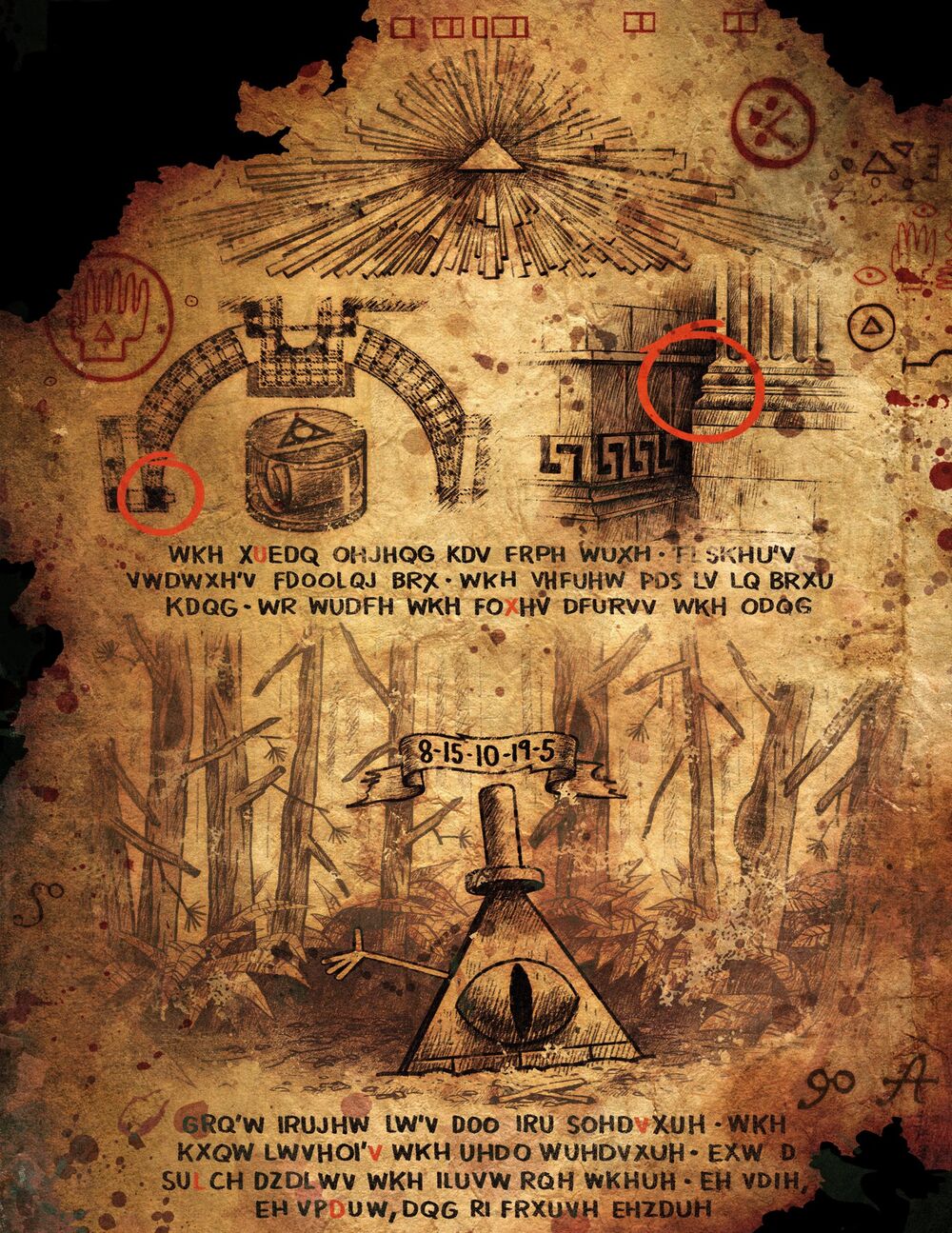
It included extra behind-the-scenes footage and a message from Bill Cipher himself. It served as a reminder that Gravity Falls would never truly end, so long as the fans were willing to engage with it.
Hunting Cipher
From all of Gravity Falls’ interactive elements, one stands among the rest. The series ended with a few seconds of footage of a real-life statue of Bill Cipher. While many fans thought the statue might be an easter egg or joke, on July 20th, 2016, Alex Hirsch tweeted an image that sent fans on a worldwide scavenger hunt to find the statue. This scavenger hunt, dubbed Cipher Hunt, put all of the fans’ knowledge and mystery solving skills to the test. It required the work of thousands of fans on location and online to decode all the messages and crack all of the clues.
Cipher Hunt took fans to Russia, Japan, and Hirsch’s hometown of Piedmont, California. Hirsch spent months curating the scavenger hunt, leaving clues anywhere he could think to. Some clues were hidden in physical locations, like a wooden ema in a Tokyo shrine or a USB hidden at a public park. Once found, the clues often asked participants to solve secret codes or play backward messages left by Hirsch. One clue was a 2,000 piece puzzle that took several days for participants to solve, while another was a set of coordinates painted on the sublevel walls at the California Institute of the Arts.
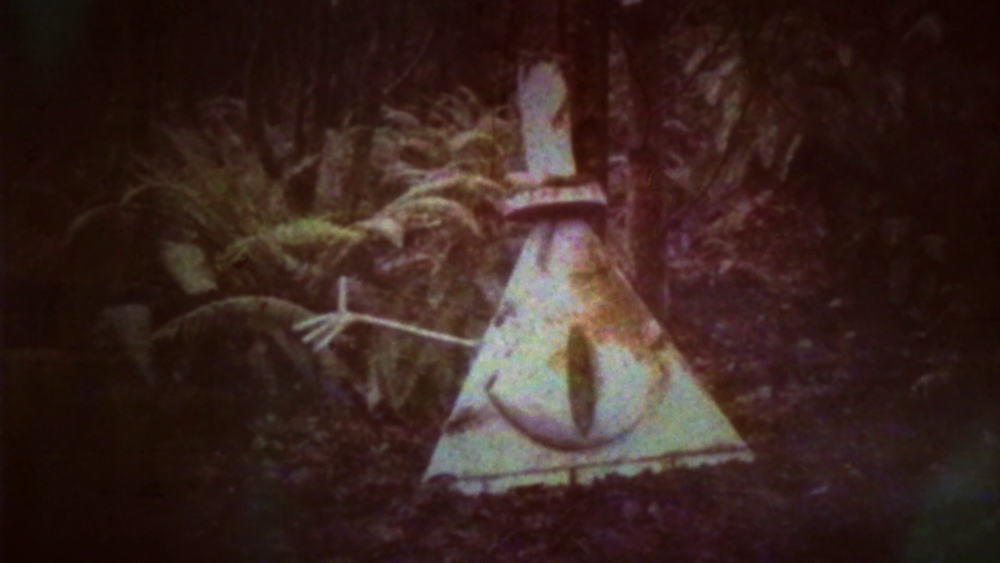
Along with the fans, Jason Ritter (the voice of Dipper Pines) and Ariel Hirsch (Alex Hirsch’s twin sister and the inspiration for Mabel) would occasionally come to help figure out puzzles or find hidden objects. Their presence during Cipher Hunt solidified Hirsch’s intention to bring the world of Gravity Falls alive for fans. For the first time, fans could openly interact with the people who helped bring the show to life. On August 2nd, 2016, the statue was eventually found in Reedsport, Oregon. Finding Bill’s statue represented the immense time and teamwork it took to follow Hirsch’s trail across the world.
The statue brought fans from across the world on pilgrimages to visit. For many fans, seeing Bill’s statue is proof of having participated within the Gravity Falls community and demonstrates their dedication to the show. Soon after, the statue was moved to its final resting place at Confusion Hill in California, which served as the inspiration for The Mystery Shack. Fans are still able to visit Bill and bring the magic of Gravity Falls to life before their eyes.
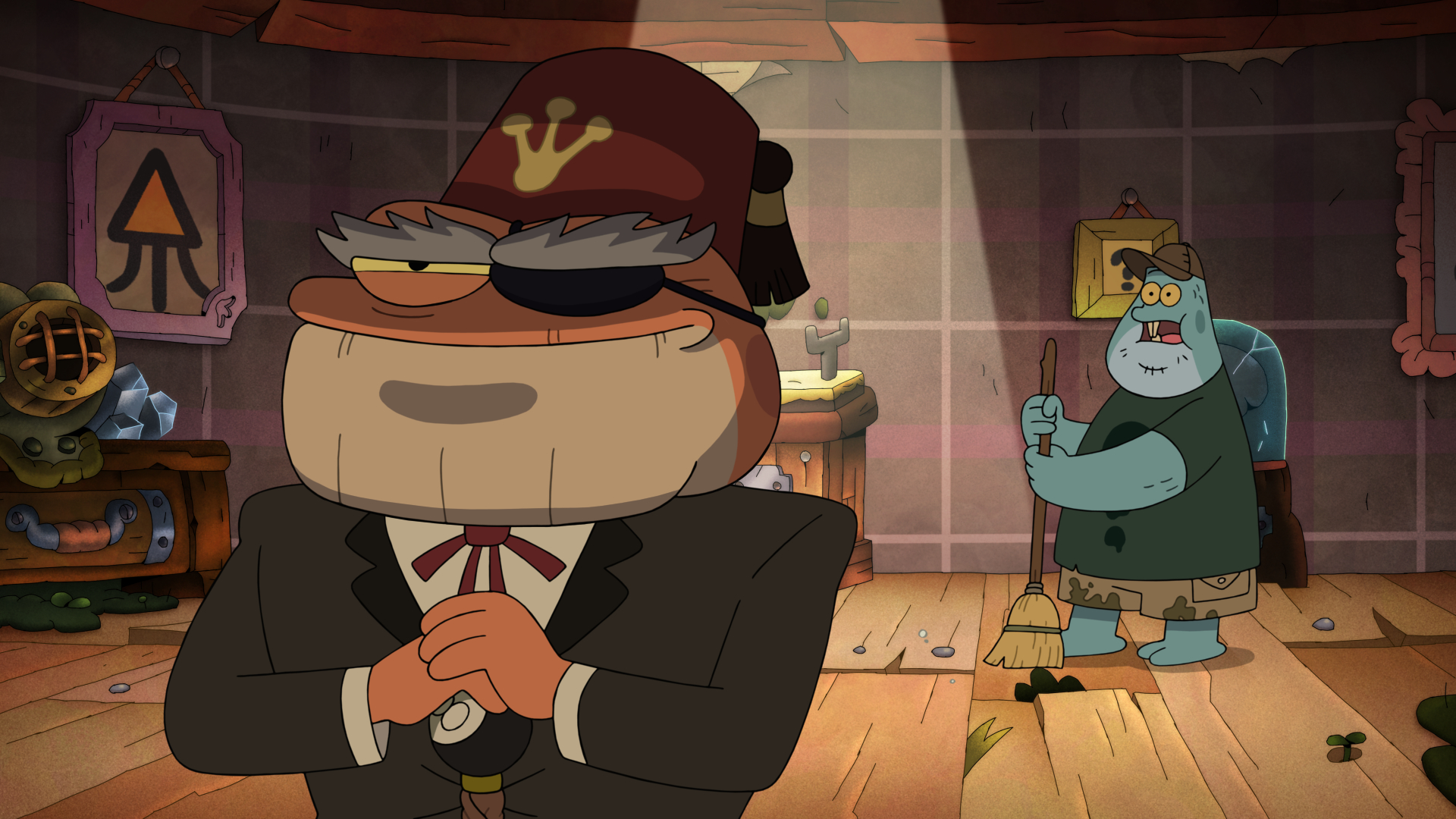
Cipher Hunt stands as one of the most ambitious forms of audience interaction ever achieved. Just as the physical release of Journal 3 helped bring Gravity Falls into the real world, this worldwide scavenger hunt was an ultimate act of love and gratitude for fans. By inviting the show into the real world and encouraging audiences to interact with it, Cipher Hunt validated audiences’ devotion to the story and rewarded them for their dedication.
The Falls Live On
The use of secret codes and paratexts in cartoons was almost unheard of before Gravity Falls hit the small screen. The idea that a children’s show could hide complex messages and codes may have seemed like a lofty idea at first, the idea certainly paid off. Audiences loved the interactive elements, and Gravity Falls’ influence rubbed off onto other cartoons.
Rick and Morty and The Owl House often reference Gravity Falls through minor background details to pay homage to its influence on animation and the idea of the interactive audience. Rick and Morty have gone out of their way to include references to Gravity Falls, including Bill Cipher in the background of “Big Trouble in Little Sanchez” and Dipper and Mabel versions of Morty in “The Rickshank Redemption,” among several others. The Owl House invented its own set of secret codes inspired by Gravity Falls and even cast Hirsch as one of the show’s leading characters named King.
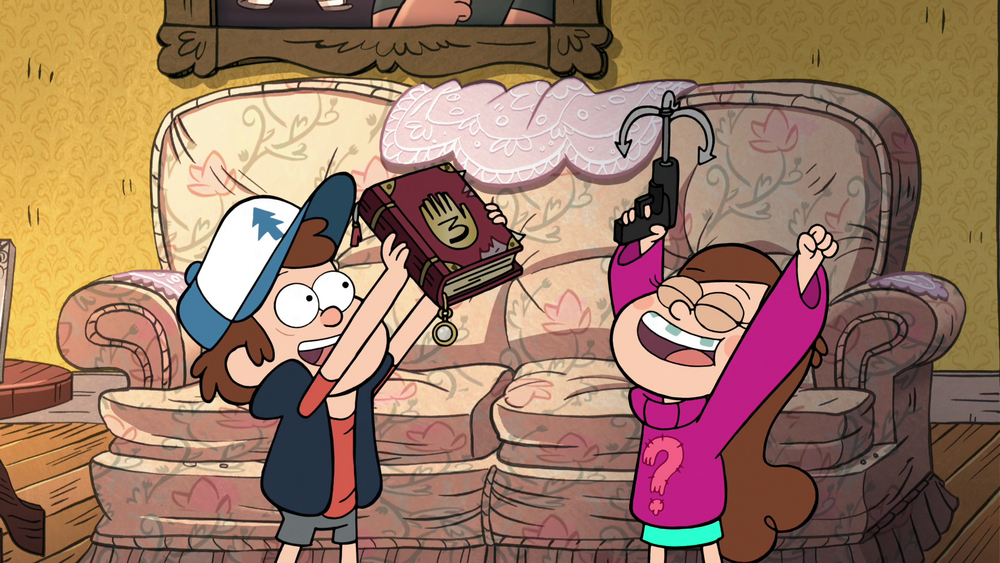
Amphibia, another Disney Channel cartoon, even hosted a crossover episode with Gravity Falls, which featured the show’s iconic secret codes for audiences to find and solve. Though nothing has been confirmed, many fans believe that the remaining answers to Gravity Falls‘ mysteries are hidden within other shows. The show’s aptitude for crossovers encourages the audience to engage with other media and constantly be on the lookout for new clues.
Why It Matters
Gravity Falls perfected the art of audience participation. Of course, there are more interactive elements not mentioned in this article, such as other books and Reddit Q&As, which show the breadth of opportunities the show created for its fans. Nevertheless, Gravity Falls stands as a beacon for what the future of television could be like and the ways audiences can be a part of the storytelling process. While most movies and TV encourage audiences to be passive viewers who merely absorb a story, Gravity Falls wanted its viewers to be active within the story’s world. Perhaps Gravity Falls will continue to inspire future film and TV creators to make stories that involve the audience as active characters in the story.
Audience interaction is not just a gimmick used to sell more merchandise or create free publicity, but rather it is a love letter to audiences. When fans fall in love with a show, they will do anything to enter into its world. Interactive elements validate fans’ love for a piece of media and encourage them to create unbreakable emotional ties with it. Not only that, but these interactive elements also can create a heightened sense of community as the audience members from around the world work together to solve puzzles or maybe find a statue hidden in the Oregon forest.
